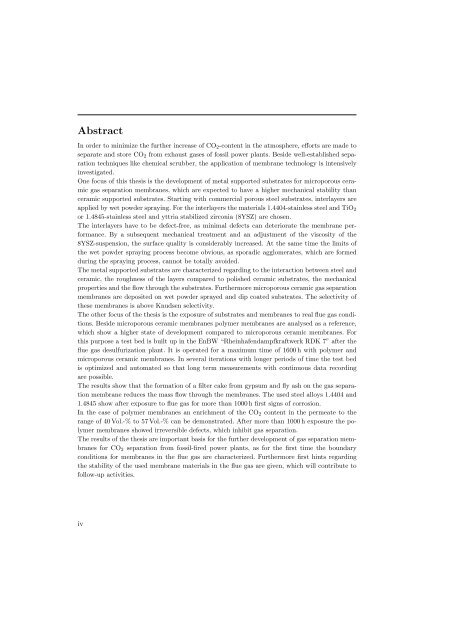Entwicklung und Charakterisierung eines metallischen Substrats für ...
Entwicklung und Charakterisierung eines metallischen Substrats für ...
Entwicklung und Charakterisierung eines metallischen Substrats für ...
Sie wollen auch ein ePaper? Erhöhen Sie die Reichweite Ihrer Titel.
YUMPU macht aus Druck-PDFs automatisch weboptimierte ePaper, die Google liebt.
Abstract<br />
In order to minimize the further increase of CO2-content in the atmosphere, efforts are made to<br />
separate and store CO2 from exhaust gases of fossil power plants. Beside well-established separation<br />
techniques like chemical scrubber, the application of membrane technology is intensively<br />
investigated.<br />
One focus of this thesis is the development of metal supported substrates for microporous ceramic<br />
gas separation membranes, which are expected to have a higher mechanical stability than<br />
ceramic supported substrates. Starting with commercial porous steel substrates, interlayers are<br />
applied by wet powder spraying. For the interlayers the materials 1.4404-stainless steel and TiO2<br />
or 1.4845-stainless steel and yttria stabilized zirconia (8YSZ) are chosen.<br />
The interlayers have to be defect-free, as minimal defects can deteriorate the membrane performance.<br />
By a subsequent mechanical treatment and an adjustment of the viscosity of the<br />
8YSZ-suspension, the surface quality is considerably increased. At the same time the limits of<br />
the wet powder spraying process become obvious, as sporadic agglomerates, which are formed<br />
during the spraying process, cannot be totally avoided.<br />
The metal supported substrates are characterized regarding to the interaction between steel and<br />
ceramic, the roughness of the layers compared to polished ceramic substrates, the mechanical<br />
properties and the flow through the substrates. Furthermore microporous ceramic gas separation<br />
membranes are deposited on wet powder sprayed and dip coated substrates. The selectivity of<br />
these membranes is above Knudsen selectivity.<br />
The other focus of the thesis is the exposure of substrates and membranes to real flue gas conditions.<br />
Beside microporous ceramic membranes polymer membranes are analysed as a reference,<br />
which show a higher state of development compared to microporous ceramic membranes. For<br />
this purpose a test bed is built up in the EnBW “Rheinhafendampfkraftwerk RDK 7” after the<br />
flue gas desulfurization plant. It is operated for a maximum time of 1600 h with polymer and<br />
microporous ceramic membranes. In several iterations with longer periods of time the test bed<br />
is optimized and automated so that long term measurements with continuous data recording<br />
are possible.<br />
The results show that the formation of a filter cake from gypsum and fly ash on the gas separation<br />
membrane reduces the mass flow through the membranes. The used steel alloys 1.4404 and<br />
1.4845 show after exposure to flue gas for more than 1000 h first signs of corrosion.<br />
In the case of polymer membranes an enrichment of the CO2 content in the permeate to the<br />
range of 40 Vol.-% to 57 Vol.-% can be demonstrated. After more than 1000 h exposure the polymer<br />
membranes showed irreversible defects, which inhibit gas separation.<br />
The results of the thesis are important basis for the further development of gas separation membranes<br />
for CO2 separation from fossil-fired power plants, as for the first time the bo<strong>und</strong>ary<br />
conditions for membranes in the flue gas are characterized. Furthermore first hints regarding<br />
the stability of the used membrane materials in the flue gas are given, which will contribute to<br />
follow-up activities.<br />
iv
















